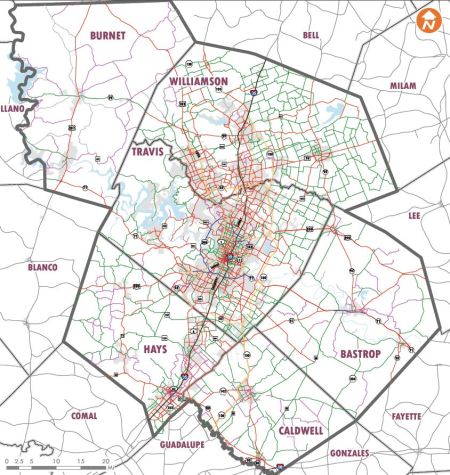
CAMPO’s 2040 regional roadway plan emphasizes expanding web of roadways catering to real estate development, intensifying addiction to private motor vehicle travel, and accelerating sprawl. Map: CAMPO 2040 Draft Plan.
♦
By Roger Baker
Roger Baker is a longtime Austin transportation, energy, and urban issues researcher and community activist. The following commentary has been adapted and slightly edited from his comments recently posted by E-mail to multiple recipients.
Most Austin folks still don’t know it (and how could they without much good investigative reporting?) but there is actually a behind-the-scenes struggle being conducted by two Austin-area real estate coalitions with quite different visions — a contest conducted through the agency of our federally mandated transportation planning body, Capital Area Metropolitan Planning Authority, or CAMPO.
For the time being, the more influential growth alliance which benefits from roads and more roads to serve Austin-area sprawl development has won out. There is also a distinctly different group of landed beneficiaries centered around a transition to high-level transit as the future mode choice. This policy difference is basically a long-lasting political battle between two politically influential real estate development coalitions doing normal business under somewhat unique circumstances.
Texas is a “property rights” fundamentalist state, in which unregulated land development is the rule in about the only U.S. state without county zoning. In light of this fact, it is easy to imagine why this land development policy difference would arise. Sometimes the development strategies of these coalitions coincide and at other times they don’t. But they are in complete solidarity when it comes to their support for maintaining maximum Austin-area tech-job-led population growth forever. The impossibility of doing that, as is now being planned by CAMPO, makes Texas politics all the more colorful and interesting.
Let us call these development coalitions first the “sprawler growthers” more closely allied with RECA (Real Estate Council of Austin), and with fast land deal profiteering their uppermost consideration. The other policy bloc is the “transit growthers“, more allied with the Chamber of Commerce and Project Connect, based on somewhat more of a long-term sustainable growth vision. The latter transit-supportive, somewhat smarter-growth coalition recognizes that with congestion becoming a major challenge to maintaining Austin’s tech-based growth, and buses caught up in the same congestion, this leaves only old-fashioned, high-level rail to serve on travel corridors like Lamar/Guadalupe. There is no other way to maintain what still remains of Austin’s severely degraded peak hour travel mobility.
Former Austin Mayor Lee Leffingwell was forced by RECA, which is the more sprawl oriented development coalition, to include $400 million in roads into his rail bond package, which ballooned it to a full billion dollars, using up all the city’s remaining high-grade bonding ability, and likely priming it for defeat. With the defeat of the billion-dollar bond package election in November 2014, and with the recent approval of the heavily sprawl-oriented CAMPO plan favored by TxDOT and the Central Texas Regional Mobility Authority (CTRMA), the sprawl-growth faction now has the upper hand. They are proceeding to build and widen roads as fast as their increasingly limited finances allow, as I’ve recently reported in a Rag Blog article:
The recent Travis County support for bringing the Rocky Mountain Institute into the Austin area planning process to tackle Austin congestion can’t change this unhappy reality very much. Nothing can solve problems that really stem from decades of anarchistic sprawl development, and at this late stage in the urban development process.
Now that Uber has created and promoted software that undermines certain traditional inefficiencies of the taxicab industry, there isn’t much to be done there. Capital Metro has gotten a new app that makes it possible for riders to track buses, but these buses are still largely trapped in congestion at peak, which remains their main problem. Squeezing what advantages are left to develop through wider use of telecommuting to eliminate physical travel might help some, but new breakthroughs in that area are getting hard to find.
Much slower regional growth will no doubt win out as the obvious resolution in the end. When things can’t go on any longer, they don’t. ■

